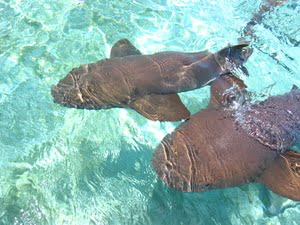Scientific Name: Bufo woodhousii folweri
Description: This toad is often mistaken for the American Toad, however they are very different. Unlike the American Toad, the Fowler’s Toad is not very plump or squat. It can be identified by a long white stripe that runs down its back and by counting the warts on each darker spot. This species of toad should have at least three warts on each spot. You can also determine the species by examining the toads parotoid glands (see picture below). On a Fowler’s Toad these glands are never shaped like a kidney, as on some other toads.
The Fowler’s Toad is commonly dull colors like brown, gray, and sometimes a yellowish color compared to other toads. They are also somewhat difficult to catch.
Feeding: A Fowler’s Toad’s diet consists of the same food you would feed most toads. Feed them 2-3 bugs every other day (depending on the size of both the bugs and toad) or 1-2 every day. They will eat crickets, moths, flies, earthworms, rolly pollies, dragon flies, roaches, ladybugs, and other insects.
Tank Setup: Fowler’s Toads are not meant for or sold for captivity. If, however, you catch one and plan on keeping it for any period of time, the following setup is recomended. Like most toads the Fowler’s Toad prefers a dryer climate. A good setup for these toads would be a 10 gallon aquarium. You should be able to house at least 3 toads in this size tank.
Cover the ground in nice garden soil. If you don’t have any in your yard, you can find this cheap, but be sure it doesn’t contain any type of fertilizer as this could kill your toad! Using soil as a substrate is especially good for toads because to stay warm during cold nights and cold weather they will often burrow underground. I suggest putting down 1-2 inches of soil.
For a more natural setting you may want to have a small corner of the tank with rocks (make sure they have absoloutly NO sharp edges and are DO NOT have a rough surface). Your best bet for rocks would be to buy some aqaurium rocks, the type used at the bottom of most fish tanks. Avoid bright neon colors and go for a more natural look. The size of the rocks, or more correctly called “pebbles”, should be medium. Small pebbles are not a good idea as toads do not have keen eyesight and when feeding may accidently swallow one rather then a cricket. If the pebbles are too small the toad may swallow it and it can cause internal damage. If they are larger the toad will spit them back out, unable to swallow them.
Never ask a pet store clerk how to house your toad! They do not know what they are talking about! A nice idea to fix up your tank would be to find a piece of bark or part of a hollow log that could work as shade or a tunnel. This will add a nice look to your aquarium and make your toad friend very happy. You will probably be able to find one of these at your local pet store (PetCo and PetsMart usually carry them) but make sure they are not made of fake substances, rather then natural wood.
Though as I said before, toads prefer a dryer climate, you will need to mist your toad, using a spray bottle, at least once a day with dechlorinated water for a significant amount of moisture. You may also consider getting a smooth water bowl where your toad can soak as well.
The above article was written from my own experiencing keeping and observing wild-caught Fowler’s Toads.
Reference:
http://animaldiversity.ummz.umich.edu/site/accounts/information/Bufo_americanus.html




